Every evening, steady streams of people race into Grand Central to get on a train and head home. They look up at the departure board, scouring it for their train, and then make their way to that track. As any astute commuter knows, Grand Central’s gates are made up of two and three digit numbers – double digits signify upper-level tracks, and triple digits for lower-level tracks. But what if I told you this wasn’t always the case – that the lower level once had single digit numbers? You probably wouldn’t believe me…
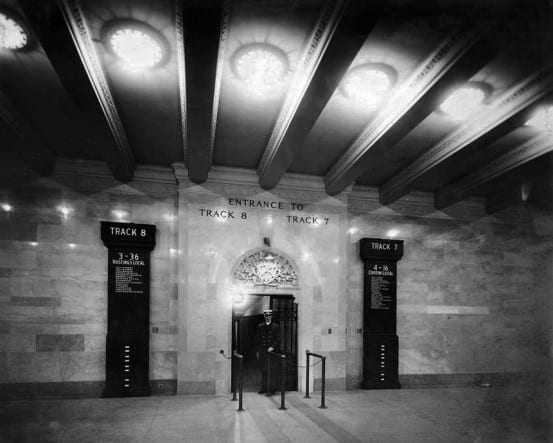
The photo that started the “mystery.” This photo from the collection of the New York Public Library shows track gates 8 and 7 in Grand Central Terminal – on the lower level of the Terminal.
If you don’t believe me right now, I don’t blame you. At first I didn’t believe it either. Plenty of books and articles have been written about Grand Central. Not one that I’ve found mentions the train gates ever getting renumbered. How could something major like this have happened in such a famous building, and yet, nobody knows about it? But as you’ll see in this post, there is overwhelming evidence that the track numbers on the lower level have been changed. In fact, you can see it with your own eyes!

Though near impossible to take a decent photo, the marks from the previous numbering are visible if you look close enough. Next time you’re in the lower level, take a look. You will see the same “Entrance to Track 8 / Track 7” as visible in the above photo.
The mystery began when I was collecting images for my Grand Central 100 for 100 project, and I found the top photo at the NYPL. It fueled my curiosity because it absolutely made no sense. Today there are no gates numbered 7 and 8. If they did exist, where did they go? But after looking at the photo long enough, it started to become obvious that this couldn’t be the upper level. The low ceiling and light fixtures bear an uncanny resemblance to the lower level. Not to mention the two trains listed on the departure board are for suburban trains, which always left from the lower level in this time period.
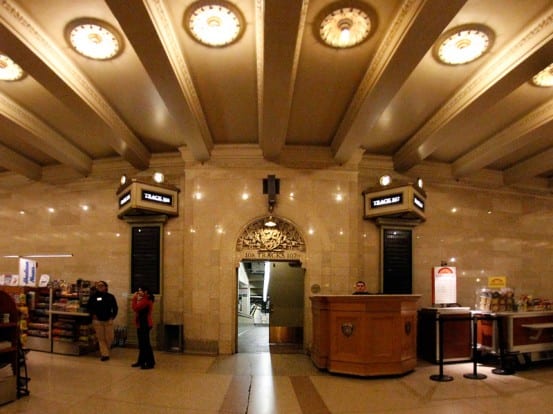
Compare the above photo with this one – a dead ringer – minus all the snack stands and junk that have appeared through the years. At some point in history tracks 7 and 8 were changed to 107 and 108.
Delving into various archives, my goal was to find other photos of the lower level with the alternate gate numbers to make a convincing case. Though the first image is nice, there is little visual information to definitively prove that it is the lower level. In fact, after showing a few people just this photo, they vehemently denied that this could even possibly be the lower level of the Terminal. Unfortunately for them, they are totally wrong. Though it wasn’t easy, I found a few more photos, a postcard, even a newspaper story showing the lower level with numbers different then the ones they have currently. Thus it is irrefutable that at some point in Grand Central’s history, a renumbering of gates occurred. Though it is possible that the numbers on lower level track diagrams have always had three digit numbers, the numbers presented to the public ridership have changed.
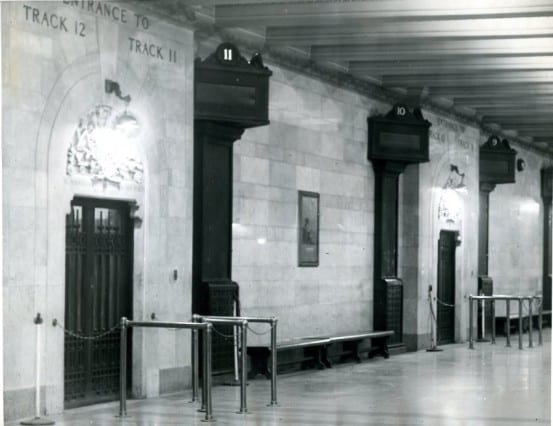
Much thanks to Carey Stumm, archivist at the New York Transit Museum, who found this undated photo in the museum’s collection.
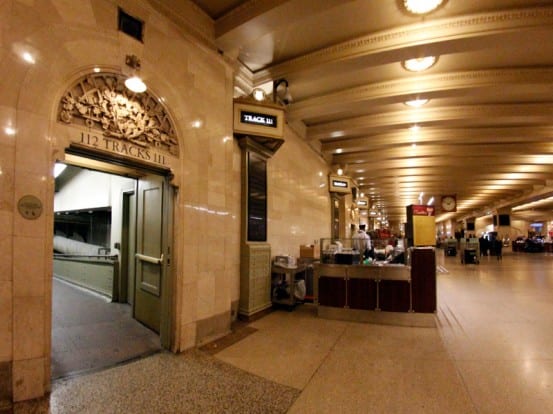
Compare the above with a more current view. Tracks 11 and 12 are now 111 and 112.
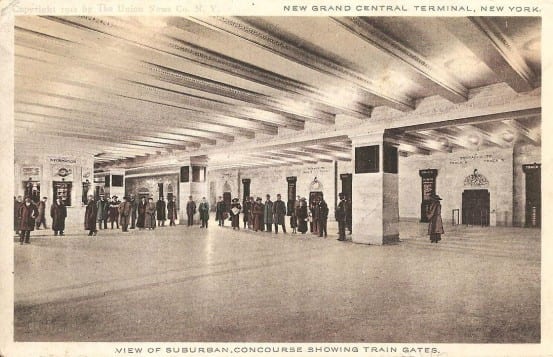
Although hard to make out, the gates on the right side are 6 and 5. Also note the lower-level information booth visible on the left side.
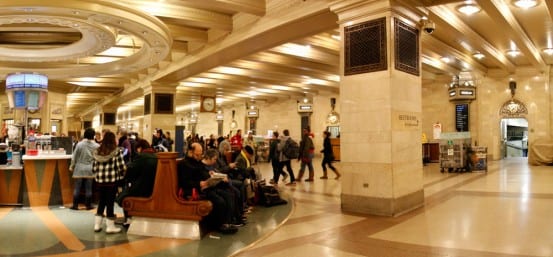
Today the lower level is significantly more filled with “stuff” than it was before, but this shot resembles the one above.
After we come to the conclusion that the lower level had single digit track numbers at one point in history, the logical next question is when and why did the gate numbers change? That is something I’ve been unable to figure out – hence the mystery of the suburban concourse! I came up with a theory, which I totally admit could be quite wrong, nonetheless I think it gets the ball rolling for us to solve this puzzle…
Theory: Grand Central once had a system of perfectly numbered tracks, consecutive from 1 to 42, across the upper and lower levels. When new tracks were added for passenger use, it disrupted this “perfect” numbering scheme.
If you’re not familiar with the current gate numbering in the Terminal, the relatively confusing arrangement is as so: tracks 11 through 42 on the upper level, tracks 100 through 117 on the lower level, and tracks 102A and 103A randomly thrown in for good measure, also on the lower level.
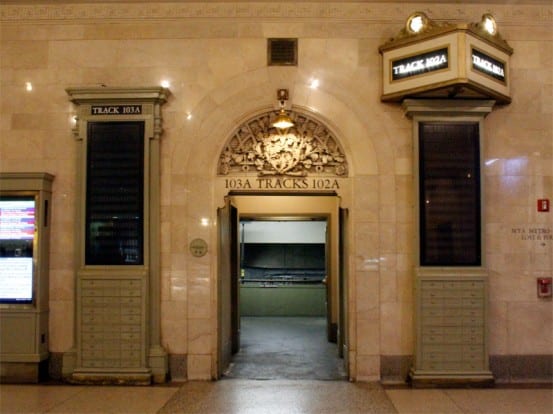
Tracks 102A and 103A randomly thrown in for good measure
Why use a numbering scheme like that, though? From a customer service perspective, wouldn’t it make more sense to start with Track 1 and work your way up? After all, every minor detail of the Terminal’s design was agonized and deliberate – from the proper letter spacing on signs for ease of readability, to the perfect grade of ramp for walking (no joke, the engineers built several ramps in the old station and watched people walk over them), even to the color of the uniforms worn by all the employees (God forbid a passenger mistake a mere hotel porter for an exalted GCT employee!). Despite all those very conscious decisions to make the Terminal easy to use for masses of people, why would the New York Central adopt track numbering that would seem completely and utterly arbitrary to any rail passenger? Perhaps it was only done begrudgingly…
First, let’s go through a rundown of facts we do know about the Terminal.
- Things we know about Grand Central:
- Trains on the upper level of Grand Central Terminal were divided into 3 categories, each split from the other, with its own location: Incoming long-distance trains (the Biltmore room and tracks west of the main concourse), Departing long-distance trains (the Main Concourse), Mail and freight trains (east of the main concourse).
- One of the design goals of the main concourse was for passengers to have the ability to see all departing trains, and quickly find their own train from anywhere in the room.
- Suburban trains were completely split off from the aforementioned trains upstairs – they all arrived and departed on the lower level. Thus the two local trains listed on the departure board in the first photo are consistent with facts.
- Confirming the premise that tracks east of the main concourse were reserved for mail and freight, plans for Grand Central call for a mail chute between tracks 14 and 15, and the platform by tracks 10 and 13 was reserved for the [American] Express Company. Some tracks on the east end of the lower level were also reserved for mail.

- Several years before the Terminal was completed, a Grand Central post office annex was built on the east side, which would eventually have access to the east mail tracks. The New York Central deeded the building to the US Government in 1932.
- The Graybar Passage has a completely different aesthetic than the rest of Grand Central Terminal, which implies that it was not built at the same time as the Terminal. Our eyes are clearly not deceiving us, we know that the Graybar building was constructed in 1926. Tracks 17 through 11 have gates here in this passageway.
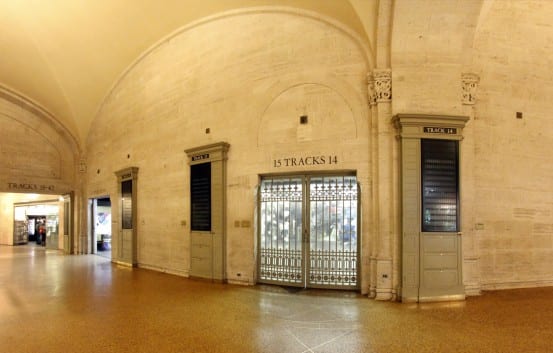
The Graybar passageway, which contains tracks 17 through 11, is a newer addition to the Terminal.
- Based upon the things we know and the visual evidence, here are the things I am suggesting to fit with my theory about the renumbering:
- Because upper-level tracks east of the main concourse were reserved for mail, they were not given numbered gates like the ones for passengers. I’m assuming the highest gate on the upper level was 18, which would coincide with tracks 1 – 17 on the lower level, hence a perfect numbering system.
- For some reason, the New York Central decided that some of the tracks used for other purposes would be converted for passenger use. Many things could have influenced this decision, including a decline in the amount of mail handled (as previously mentioned, the NYC deeded the Post Office annex to the US Government), and more passengers than they thought would be using the station, especially during the war.
- When these new gates were added, it made Grand Central’s gate numbering inconsistent (there would have been two gates numbered 17 through 11, one each on the upper and lower levels). Thus the lower level gate numbers were changed to 3 digit numbers. The gates in the first photo – numbered 7 and 8 – were now 107 and 108. Although the gates no longer had a logical order, opting for this scheme reduced the amount of people affected by the renumbering. When converting the lower level mail gates, numbers really got messy, thus the reason for the bizarre gates 102A and 103A. At minimum, the three digit gate numbers helped to differentiate what was on the upper and lower levels.
- These added gates on the upper level made it so passengers could not see all trains departing while standing in the main concourse (one of Grand Central’s ease of use important concepts). Thus a compromise was reached – departure signs for those tracks outside the concourse were added to the archway:
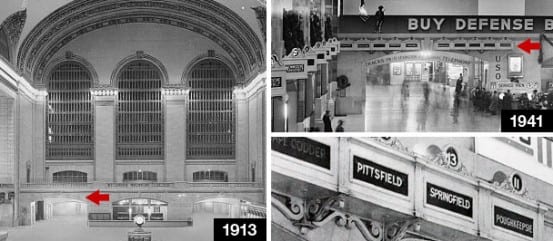
Of course, everything above is all speculation. But it addresses the two major questions regarding the numbering – why were the numbers changed, and were there duplicate numbers on the upper and lower levels. If today’s track 111 was just 11 in the past, and there was also a track 11 on the upper level, that makes two track 11’s, and double the confusion. It seems to make more sense that the upstairs 11 was not there yet for passengers.
As it is right now, I don’t think there is anything more I can really do to figure out this mystery. Thus I am opening it up, and presenting everything I’ve found to you all. Someone out there may have a photo, or a timetable, or another bit of info that sheds some light on this situation. Collectively, I think we can figure this out – when and why were the track numbers on the lower level changed? Have any thoughts, clues, or evidence? Post in the comments below!

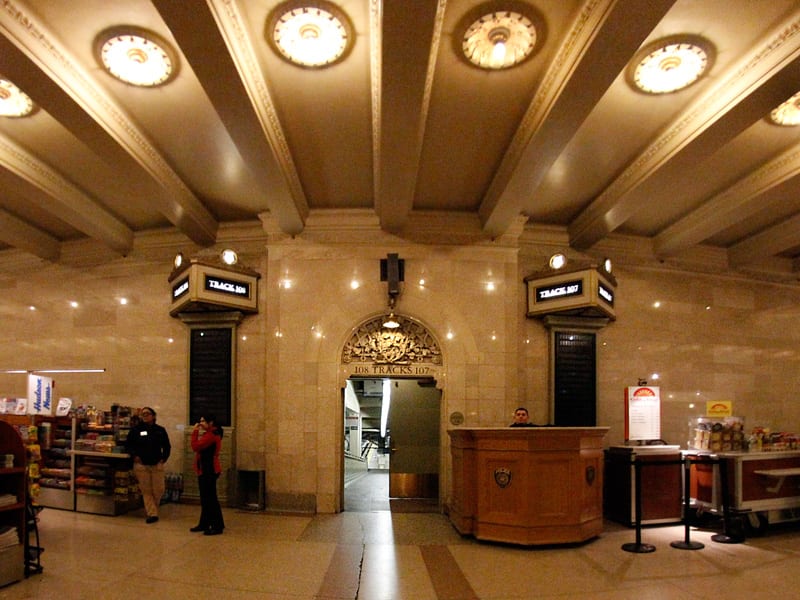
This is a fascinating find. In the 16 years I’ve been studying the terminal, I never came across anything about the lower level having numbers other than the 100-series scheme. I have old track maps, which are revised versions of the originals (from the ’50s) that list the tracks in the 100-series on the lower level.
You stumbled onto some interesting thoughts. One of which was the adding of passenger tracks. It wasn’t so much that tracks were added over the years, but rather, the terminal was built in small sections called “bites,” from east to west. So when the first ‘bite’ was completed, it was opened (on two-levels) and the construction moved west. It’s possible that in the beginning, since only a fraction of the terminal’s entire two-level track system was opened at any given time, all tracks were merely numbered the same on both levels (since movement between the levels may have been difficult during construction, and specific railroads were assigned to each level). Once the terminal was done, and the flow was fully opened up, the need arose to clearly delineate the upper and lower levels.
The fact that track 11-12 became 111-112 indicates, though, it was a mere adding of the digit that changed, not a renumbering of the track sequence.
This is a good mystery…
At first I thought that maybe the tracks were single digits when the lower level first opened, and it was changed to the current 100-series once the rest of the Terminal opened. I know that the suburban concourse opened in October of 1912, and then the rest in Feb 1913, so it could make sense. The only thing is if there are still marks that are visible (albeit barely) from the old numbering, those numbers were probably up for a while.
Of course, the lower level opened before the upper. That would make sense. Though, track maps seem to suggest the lower level always had 100 series numbers, so maybe, as you said, the ‘passenger facing’ designations were not 100’s. Then when the upper level opened, they changed the signage.
It would be nice to know exactly when, though it’s one of those things that seems like no one documented it.
Right, I think that is why most people were reluctant to believe there was a renumbering. I have 1912 diagrams that show 100-series numbers. But the tracks that the railroaders needed to know didn’t necessarily have to sync with what they showed the public.
Though if that’s the case, why didn’t they begin the “passenger numbering” with 1, instead of 17 (or whatever the first UL track was) on the Upper Level. The public sees the same numbers as the actual tracks. Likely because mass confusion would occur, even for employees, having different numbers used inside the terminal bldg vs. the track area.
Do you have pictures of the ’50s era Solari board from GCT? Because I remember the 80’s OMEGA board had separate columns for Upper Level tracks and Lower Tracks, with the LL column having three digits for track numbers. So even then they felt compelled to call out the level the train was on (unlike today, where it’s assumed a 100 series track is LL). Maybe an old photo of the board will yield a clue.
That is actually not a bad idea… I think people took a lot more photos of the upper level as opposed to the lower, so finding images of the departure board may be helpful. Will have to see if I can find some…
A photo which appears as a plate in David Marshall’s book, GRAND CENTRAL, presents the lower concourse at 4 AM, with the gates at the right, and from what I canmake out, the nearest gate is number 6. The other gate numbers are
not visible.
Wouldn’t dare try to add to the discussion. I’m just fascinated by it all, and your theory sounds highly plausible. Thanks for keeping me riveted!
Well thanks for dropping by, and for the comment!
It’s always fun to follow the thinking of a logical mind. And though I’m afraid I have nothing to contribute to the solution of the mystery, I couldn’t help but think of King’s Cross railway station platform 9¾ (not that I’m a Harry Potter fan, having read none of the books nor seen any of the movies).
Interesting stuff. What really caught my attention was the photo with the Pittsfield destination. It would be great to see photos with destination signs that are no longer seved. Maybe the old solari board. Places like Chatham, or even Litchfield would be great. Anyway intriguing things about GCT. Thanks for the all the research you do and your good work.
Back in the old days there were some Harlem Division trains that would follow the B&A from Chatham up to Pittsfield and North Adams, which is actually pretty cool. You might like this photo, shows a GCT departure board for a train heading to Idaho :)
Thanks for the link. Now that my interest is sparked I may try and do a little digging myself.
Oh, Millerton was a given, but that was part of the original Harlem. Pittsfield and North Adams were funky add on bonuses :)
Utterly fascinating. You have me hooked. Enquiring minds want to know!
The platforms at GCT, though, were high-level from day one (Day one of the 1913 terminal, that is). I was under the impression the A designation (and forced loading on one side only) was due to platform gaps between car and platform (resulting from longer cars one the lower level platforms).
The Pittsfield train alluded to on the archway was, undoubtedly, a New Haven train. If I’m not mistaken, the entire east side of the station back in the day was given over to the “yankee railroad,” the NH.
Shh… I like to talk about the Harlem Division whenever I can. Pittsfield and North Adams still showed up on our form 112’s until the early 50’s ;)
It never occurred to me that there was a logical sequence of numbers starting on the lower level and moving to the upper. I just figured they announced “track 15, upper level” or “track 15, lower level” whenever there was a conflict.
The building of the Graybar Building and its passage is key, though. Tracks 1-17 on the lower level; tracks 18 to 42 on the upper. The Graybar tracks just seem too haphazard to have been planned for passenger use from the start. Take a look at today’s platform between tracks 16 and 17, the westernmost in the passage: it has terrible visibility (you can’t see your train on track 17 until you’re next to it) because of the huge supports on the platform, which, I imagine, support either the Terminal itself or the Graybar building.
The other tracks in the Graybar passage are just as bad. Track 15 is lower than the others, and it’s platform-mate track 14 is still used for garbage loading, never for passengers. Tracks 13 and 11 don’t even have a ramp (I suppose 12 never existed or is under the 13/11 platform).
This makes the planning involved in the terminal even more incredible. Somehow the track numbers lined up so that tracks 1-17 on the upper level wouldn’t have public platforms, while tracks 101-117 on the lower level would, so that the platforms could be numbered from 1 to 42. This is quite an amazing thing you’ve found here.
Whilst working in the Terminal (1963-’68) as an “Air-Rights” construction superintendent and NYCS coordinator, I remember tracks 11-13. There was no track 12, as the space was taken up by mail handling chutes-and-ladders. No passenger tracks east of 11, just storage. The express company service was long gone. Lots of NYNH&H mail trains. A few NYC, too. “Famed” (FDR) track 61 was a dirty mess and used to lay-over FL9s, etc.. Tower “C” handled all of this.
i am not sure everybody knows,that there are only 22 FL-9’s left,38 were cut up for scrap including the FL-9 a/c,models that were test beds for the Long Island,DM 30 a/c dual modes.it is a shame when a railroad or an agency who owns a railroad cares more about money then history,which will bite them in the pants.i am lucky i own 3 FL-9’s in HO-scale.1,brass,from The caboose,in conn.and 2 others by Mark Castaglione.of Branford Hobbies,in Branford,Ct.i hope that the people in power have the compassion to keep the other FL-9’s from being scrapped.maybe some one should have their cars scrapped,let them know how other’s feel.The maybe no snap judgements.Thanks,have a great weekend,and God bless.
Great work! Please keep posting your Blog; your efforts and interesting style is appreciated.
You’re all likely to already know about it but I just came across this site which has links to the track plans (which are actually “leverman’s diagrams” showing where all the switches are). Very cool. And complex!
Just came across your great site. One minor correction. You note the reference to the Express agency as “(American) Express.” I am certain this is wrong. All the railroads partiicpated in the Railway Express Agency, noted in its very last years as REA Express. Most passenger trains had some combination of baggage, mail and express cars immediately after the locomotive and before the passenger cars. You can find its whole story on Wikipedia. American Express was in the travel and banking business, but had no need for railroad platforms.
There was an American Railway Express Company. I don’t know if it became the American Express of today. Old depot photos sometimes have a sign on them with this name.